

Robert Stroud: The Birdman of Alcatraz. Just leave out either the birds or Alcatraz
In 1962 MGM released the movie "The Birdman of Alcatraz". Starring Burt Lancaster, it depicted the story of how two-time murderer Robert Stroud, originally incarcerated at Leavenworth and then transferred to Alcatraz, began to pass the time by studying the diseases of the sparrows and canaries that he kept as pets. By first hand observations, he had not only determined the hitherto unknown causes for a number of diseases that afflicted the common domesticated birds, but he even went so far as to actually develop as many as eighteen specific cures. What was even more amazing for a man who had minimal formal education, he published his findings in two books: "Diseases of Canaries" and the monumental "Stroud's Digest on the Diseases of Birds". And so in spite of the brutalizing and demeaning prison system, a near-psychotic murderer was transformed into a thoughtful and humane scientist soley through his own efforts. The movie closed with the statement that Robert Stroud was still in prison and had always been denied parole.
Immediately there was a hue and cry from the average theatergoer and celebrity alike to pardon this kind-hearted gentleman genius. Tables were set up in the movie lobbies where you could add your name to the list of what would eventually be over a hundred thousand signatories seeking to have Robert freed. Moviegoers flooded the justice department with letters, saying how they had seen the movie and just couldn't believe Stroud hadn't been pardoned. Burt Lancaster even stepped in and offered to have Robert paroled to him.

Burt even offered to have Robert paroled to him
People were flabbergasted (and some still are) when a year later Robert Stroud was allowed to die in prison. How could the government be so intractable? Well, what could you expect of a country that had a prison system which was so despicable and inhumane and where the administrators and guards really deserved incarceration more than the inmates?
The truth was Robert was in prison for a pretty good reason. While a teenager in Alaska, he committed an apparent execution style murder because a man had refused to pay one of Robert's lady friends her full ten-dollar fee. Since Robert got a percentage of the lady's income, he went to the man, knocked him out, and shot him in the back of the head. The exact circumstances were admittedly a bit vague and given the obviously questionable reputation of his victim, Robert was able to wrangle a plea bargain for manslaughter. Since the crime occurred in Alaska - then a US territory - he was sent to McNeill Island Federal Prison in Puget Sound just off the coast of Washington state to serve his twelve-year sentence. This was in August 1909.
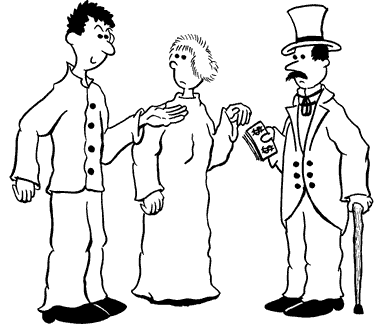
Robert got a percentage of the lady's income.
Not all of the movie was Hollywood hype, though. Robert really did have superior intelligence and possessed a natural aptitude for learning. At MacNeill he improved his reading skills to where he could understand and work college level engineering and physics problems. Likewise his writing progressed from a barely literate scrawling to a quite polished and lucid style.
The movie also started out portraying Robert fairly accurately. At the beginning, Burt was scarcely a model prisoner and neither was Robert. Like many inmates in the early 1900's he used morphine (which was easy to obtain), and he and another prisoner set up a nice business dealing in the drug. But somehow his partner spilled the beans to the warden. Actually this in itself wouldn't have been such a big deal. After all, at the time possession of morphine was hardly considered breaking the prison rules (having stamps to mail illicit letters was far worse), and the warden didn't do much. But as Robert had spoken openly and frankly to the warden about the matter, Robert was afraid he might look like a stoolie. In prison, then or now, that's about the worse thing you can be, particularly if you want to stay alive.
Since his partner started the whole thing by blabbing to the warden, Robert decided it was all his fault. So he took a typical Robert Stroud approach and stabbed the man in the back. Exactly what really happened is hard to sort out since Robert had a tendency to change his story as time went on. At first he said he was trying to kill the man and was sorry he didn't. Later on, he said he was just trying to frighten him. If that was the case, he must have REALLY wanted to frighten him, since Robert chased his friend down the corridor stabbed him seven times. In any case, the wounds weren't fatal and Robert was only given an extra six months plus loss of his "good time" credit. But he was also tagged as a dangerous and violent inmate, which is certainly a difficult assessment to argue with. So Robert was sent to Leavenworth.
In Kansas, Robert began serving his time without too much trouble. He had some disciplinary reports lodged against him, but not for anything worse than was incurred by most other prisoners. And he continued to study math, physics, and even music.
At Leavenworth, he kept in touch with his mother, Elizabeth. Since it had been difficult to handle her son's legal affairs from Alaska, she had moved to Kansas. Like most mothers of convicted killers, she thought her son was really a "good boy" who didn't deserve to be in jail. In 1916 she wrote to him saying he might be freed in a year. This was true enough. Robert had by then served seven years and could easily have been paroled. But then he really blew it.
Robert's younger brother, Marcus, had decided to stop by Leavenworth. Robert hadn't seen him in eight years and was really looking forward the visit. But as he was eating, he broke some dining hall rule. Probably he was laughing or talking too loud, and a nearby guard said he would report him. Trivial as it seems, this infraction would have been enough to cancel his brother's visit.
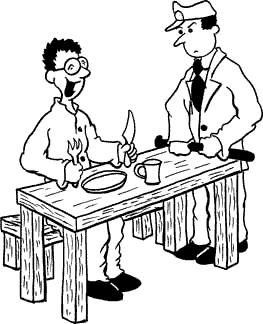
Robert said he just got carried away.
Robert maintained he was simply happy with the idea that he would see his brother, and got carried away. Words passed between Robert and the guard, and Robert said the guard called him a "cork sacker" or "coke soaker" or something like that. Then according to Robert, the guard reached for his club. To protect himself, Robert pulled out a concealed knife and killed the guard.
Once more, it's difficult to know how much of Robert's stories were fact and how much was fantasy. Another guard said he saw Robert and the guard talking, but that Robert suddenly reached for the guard's club. On the other hand after Robert had stabbed the guard, he appeared to be completely stunned by what he had done and immediately surrendered his knife without a struggle.
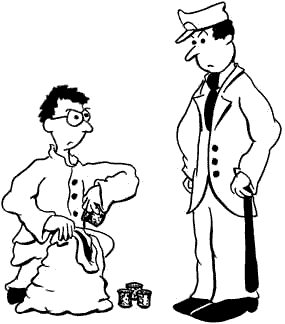
The guard called Robert a cork sacker or something like that.
Even if there were (as is likely) some extenuating circumstances here, a prisoner killing a guard was about the worst thing that could happen, either for the prisoner or the guard. Robert was tried and sentenced to hang. His mother hired a lawyer and managed to get the case thrown out. A retrial was ordered, and Robert was again found guilty, but at least this time the sentence was reduced to life in prison. You'd think this would be good enough for both Robert and his mother.
Nope. Elizabeth wanted an acquittal, come hell or high water. Somehow she managed to get the second trial thrown out as well. Again Robert was retried and was once more found guilty. But this time, after more than two years of trials and retrials, he was re-sentenced to death. Elizabeth tried AGAIN to get the case thrown out, but to no avail. Robert's death sentence was upheld.
The only recourse now was executive clemency. This might seem a steep order - after all, it required personal action from the President of the United States - but from notes in the prison records it seems that Elizabeth had a decided knack in making good impressions on people. Whether that was the case here or if it was the genuine merit of the arguments that her son had received a horribly unfair trial (which by modern standards he had), she went to Washington and was able to wrangle the commutation out of President Wilson. Robert once more was relegated to prison for life.
To say Wilson's Attorney General, Alexander Mitchell Palmer, and the rest of the prison administration, wardens, and guards were displeased with the President's action is the world's greatest understatement. But if the President was going to be soft on criminals, by golly, his attorney general wasn't. Attorney General Palmer promptly issued a directive that Robert was to be held in solitary for the rest of his life. Such an order was, of course, totally and completely illegal, but such things never bothered Palmer who even by the standards of the early 1900's outraged many Americans by his flagrant trouncing on civil rights. In any case, Robert remained in solitary for the next 40 years and the order remained in force long after Attorney General Palmer was dead and gone.
Solitary, though, was not as most people picture. It did NOT mean Robert was thrown into a windowless, lightless cement-walled cell devoid of any furniture and allowed light only when eating his meals. Although in virtually all American prisons, there WERE windowless, lightless cement walled-cells devoid of any furniture where light was allowed only when eating, these were mostly used as short-term punishment to make the violent and dangerous inmates cool down.

Robert's solitary is not what most people picture.
Actually there is confusion between the prison jargon of "solitary" and "segregation". A prisoner in solitary may indeed be kept by himself, seeing no one, and allowed no yard privileges. An inmate in segregation, though, is kept from mixing with the main population of prisoners, usually to protect either himself or the others. He can, though, if he wishes, talk with others in the neighboring cells and might permitted time in the prison yard.
Robert's status was actually segregation. He was housed in a standard Leavenworth cell, and there were other prisoners in surrounding cells. And he was allowed out in the yard for exercise, although generally not with the rest of the prisoners.
It was in the yard at Leavenworth that (according to the most repeated story) he found an injured sparrow and took it back to his cell. This is probably more or less the way it happened, and there was nothing unusual about it. Prisoners were often allowed to keep birds, and before long Robert had a cell full of them.

According to the most repeated story, Robert found an injured sparrow in the prison yard.
With nothing much else to do, Robert began to study his birds. And when some of them got sick and died, he began to wonder about the cause. He read what was then available on bird diseases and started doing autopsies. Eventually he began to come up with some theories about what caused his birds to get sick.
Not content with just finding the why - or at least, what he thought was the why - Robert also began to experiment with cures. Eventually he developed a concoction that he called "Stroud's Specific". This was the first of a number of "specifics" Robert invented, and like all of Robert's remedies, it was just simple inorganic antiseptics dissolved in water. These would have had no effect on either bacterial diseases or viral infections. But although modern veterinary opinion trashes his cures as worse than useless, it has to be remembered that this was in the pre-antibiotic days when veterinarians were still dosing animals with mixtures of turpentine and chloroform to get rid of throat worms. Robert for his part always swore by his medicines, but readily admitted they became obsolete once antibiotics were discovered.
In 1921, a bit of good luck also came Robert's way. The old warden at Leavenworth was replaced by a reasonably farsighted professional named William Biddle. A former journalist with an eye for publicity, Warden Biddle recognized that Robert and his birds could be a great way to tout Leavenworth as a progressive institution where rehabilitation was the name of the game. He permitted Robert to buy more books and lab equipment and made sure that prison visitors saw Robert during their VIP tours.
Robert soon had a nice set up. He was given an extra cell to keep his birds - an amazing luxury given that at that time Leavenworth was so crowded that some inmates were sleeping in the basement - and began corresponding with bird breeders and contributing articles to avian magazines. By that time Robert could write quite well, and readers became intrigued by the Leavenworth-housed bird fancier. Robert soon acquired a surplus of birds, mostly canaries, and Warden Biddle had no objection to his selling them by mail order to bird aficionados outside the prison. Robert also sent out ads to market "Stroud's Specific", and soon, though by no means a famous man, he became reasonably well known to a number of America's bird lovers.
As the business began to grow so did Robert's needs - or at least his demands. He asked for (and got) more seed, more cages, and more equipment and chemicals. The latter included ethyl alcohol, ostensibly for cleaning out the cages, but also quite suitable for drinking, and some of the supplies he received could - as Robert himself pointed out - easily have been used to help him escape. But all in all, Robert was fairly contented and never gave any serious thought to escape.
All in all, Robert Stroud at Leavenworth was good publicity for Warden Biddle. And the truth was, if Robert wasn't exactly making a profit from keeping his birds, he was certainly helping defray the cost. "Stroud's Specific" sold for $2 a bottle, but he made his real money selling the birds. Although he claimed he could get as much as $50 for a single bird, this may be based more on enthusiasm than his actual account sheets. But his canaries did bring in $7 to $25 depending on the pedigree. The prices may not seem like much, today but in the 1920's and 30's one man could easily support a family and live reasonably well on $150 a month.
And it was at Leavenworth that Robert gained his real claim to fame. He wrote his two books: "Diseases of Canaries" and "Stroud's Digest of the Diseases of Birds". They are still in print, mostly as curiosities, and the truth is that some of their remedies can actually kill a bird. That doesn't mean modern avian veterinarians totally discount Robert's work. He was a careful and meticulous observer, and when he insisted that birds needed as careful attention as other pets, he was ahead of his time.
By the 1ate 1920's Robert was corresponding with a lot of bird lovers, and this began to present some logistic problems for the prison administration. The letters of all the prisoners - both into and out of the prison - had to be read and approved. Generally the people who wrote to Robert were both the curious, intrigued by the Birdman of Leavenworth who wrote such authoritative sounding articles, and also those who were genuinely interested in raising and caring for their pets. Then Robert received a most enthusiastic letter from a young woman named Della Jones, who had read one of his articles. Robert wrote back a gracious reply and soon the two were corresponding regularly. After a time, Della decided to pay Robert a visit.
As soon as she met Robert, Della was smitten. In fact, she became so infatuated that she immediately moved to Kansas just to be near him. She also met Robert's mother and the two ladies shared neighboring apartments. But rather than helping Robert out, having two such adoring ladies lavishing their attentions on him actually did the fellow in.
The trouble was that from the first, Elizabeth didn't care much for Della and her starry eyed adoration of her son. And as Della and Robert became more involved - or as much as they could given the circumstances - the word got out that they were going to, or actually had been, married. Both versions of the story appeared in the newspapers, and it appears the sources of the information were Robert and Della themselves.
Well, as soon as the newspapers reported that Della was claiming she and Robert were man and wife, Elizabeth had a fit. She immediately moved out of her apartment and left town.
From then on Elizabeth had nothing further to do with her son - or at least nothing beneficial. The next time Robert's parole hearing came up, Elizabeth told the board that her son was as dangerous as he had always been and shouldn't be released. Naturally, having your mother oppose your parole doesn't help you get out of jail, and Robert never did.
Shortly after the story that Robert and Della were married began to circulate, things began to cool off between them. Eventually she dropped out of his life. That was around 1936, and a couple of years later, Elizabeth died. Robert drifted along at Leavenworth for six more years, and then he was transferred to Alcatraz.
All right. Why after more than thirty years in Leavenworth and eight years after Alcatraz opened was Robert sent to the Rock? Admittedly Robert had become an increasing logistic problem for the administration. All his correspondence had to be read, copied, and approved, and the prison clerks were spending more time on Robert's mail than on most other prisoners combined. He was always demanding more equipment, chemicals, and books, and he could have justified a full time secretary just for his bird business alone.
Another more practical problem was, unlike the fastidious and nearly antiseptic Burt Lancaster, the real Robert was pretty much a slob. The guards had to continually get on his case to clean up. Robert also let his birds fly around his two cells as they pleased, and as birds drop their droppings about every fifteen minutes or so, his living quarters became rather disgusting. Since the birds would sometimes settle and sit on Robert, he could become a bit ripe himself. And given the fact that to counter the hot Kansas summers, he often went about in the buff, he must have been quite a sight for the newer guards.

Robert must have been quite a sight for the new guards.
Another thing that tended to gall the administration is that Robert never showed any gratitude for his special privileges. He never accepted that his being in prison was justified, and at times he even seemed to go out of his way to irritate the prison officials. At one point, Homer Cummings, then director of the Bureau of Prisons, gave Robert the opportunity to have his bird business made an official part of the Federal Prison Industries. Homer said he would even put Robert in charge. Incredibly Robert turned the offer down, but nevertheless continued to make more and more demands. As far as Robert was concerned, everything he received was his just due, and eventually everyone from Leavenworth to Washington was fed up with Robert and his birds.
At a more personal level, Robert was also not a particularly easy man to deal with. The Birdman movie, although in many respects a balanced portrayal of early life at Leavenworth and Alcatraz, doesn't really capture Robert's volatile and changeable personality. Although he did have some friends, in general prisoners didn't like him and considered him argumentative, divisive, and even dangerous. When one inmate learned the movie had prompted a "Free Robert Stroud" movement, he scoffed, "They don't want to pardon Robert Stroud. They want to pardon Burt Lancaster."
Robert certainly could give the impression that he was unstable, and in conversations could swing in an instant from congenial and witty banter to a vindictive, irrational, and frightening tirade. This all depended on who he was talking to. So while one prisoner might remember him as a witty intelligent man with a puckish sense of humor, another inmate would recall hearing him unleash a babbling frenzied diatribe of how he would kill the children of the guards. The last story was related by none other than Alvin Karpis, who always said the decision to refuse Robert parole was the correct one. So if Robert made that kind of impression on J. Edgar Hoover's "Public Enemy Number 1", you can imagine how a parole board would feel.
Eventually, Warden Biddle moved on. His replacements may have been interested in their unusual prisoner at first, but soon found the novelty wore off. As far as they were concerned, Robert, his special privileges, and his birds were nothing more than a first class administrative headache.
None of this, though, would have justified a transfer to the country's worst punishment prison. It was after all designed for the big name, big time, and most notorious gangsters (of which Robert was not) or the incorrigible, dangerous, and the escape risks, which at this point didn't really fit Robert, either.
The official reason for the transfer was that the war had made Robert's bird business too expensive to maintain. Of course, they could have just taken away his extra cell and shut the business down, but they didn't. So why was Robert transferred to Alcatraz?
The truth is hard to avoid. The original order by Attorney General Palmer had instituted an unspoken but very real policy of vindictiveness toward Robert throughout the prison system. Robert had, after all, killed a prison guard, and few of the prison officials thought Robert's sentence should have been commuted. And once he started getting publicity in the press, well, that was just too much. Sending Robert to Alcatraz was the perfect solution for everyone, except, of course, Robert.
On December 16, 1942, the guards went to Robert and told him he was being transferred. He was put on a special train and sent to San Francisco. His cells at Leavenworth were searched, and the guards found a small still for making illicit booze and a homemade dagger.
Although Attorney General Palmer had been dead for six years, his "life in solitary" order still held. So once on Alcatraz, Robert was put in one of the special "D" Block cells. D Block was for segregation and isolation, and the prisoners were in their cells virtually around the clock. They ate in their cells, had restricted time in the recreation yard, and were not permitted to work. But they could still talk with their neighbors, though, and play cards, checkers, or chess.
In the movie, by the time he got to Alcatraz, Burt had mellowed into an elderly philosopher/scientist who was on first name basis with top-level prison official Karl Malden, who kept cropping up as a warden at whatever prison Burt happened to show up at. That one prison official would bounce around like that wasn't impossible, but neither was it factual. Actually Karl was a combination of Warden Biddle, Alcatraz Warden James A. Johnston, and the head of the Bureau of Prisons, Homer Cummings. Although irritating to historical purists, this literary compression was pretty much necessary to make everything intelligible within the limited time allotted for a typical 1960's motion picture.
The "Birdman of Alcatraz" is often criticized because it makes Robert look like a saint - and even his friends knew he wasn't that. But at least unlike some movies about Alcatraz which show the guards as sadistic and near insane brutes who pummel the inmates for the pleasure of it, Alcatraz is depicted remarkably accurately. It shows that Robert was permitted time in the prison yard and was not thrown into the isolation cells with their solid reinforced steel doors. More importantly, far from being the sadistic monsters so favored by the Hollywood scriptwriters, the guards are shown behaving in a correct, although impersonal manner toward the convicts. This, too, is accurate and was behavior intended to be as much for the guard's own safety as it was to control the prisoners. All in all, it's not a bad movie.
But there is enough fiction, though, to trap the credulous and tenderhearted viewer. There is, for example, the scene where Burt walks into the cell from the recreation yard and finds the warden reading the book Burt had been writing about prison life. Karl was deeply offended by the negative tone of what Burt had written, since he felt he had always been a progressive warden. So he confiscates the manuscript. Actually, Robert really HAD been writing a book about prison life, but it was with the full knowledge of the Bureau of Prisons. The manuscript was never confiscated, but neither was it allowed to be published.
But what about the part where Burt helped quell a prison break out and riot? Did that happen?
Well, yes and no. In the movie,"Bern" - the fictionalized version of Kentucky bank robber and moonshine runner Bernard Paul Coy - seizes a rifle and pistol and then organizes a massive breakout attempt. The gist of all this does roughly follow the true-life 1946 "Battle of Alcatraz". Again much of the action was compressed. For one thing, Coy did NOT shoot down an unarmed guard early in the escape. THAT was done by Joe Cretzer, Coy's partner in escape, who in cold blood shot not one, but nine guards being held hostage in a cell, an incredibly stupid act which amazingly resulted in only one fatality.
It was also stated by the voice-over that the "arms" seized by the convicts consisted only of a single rifle and one pistol. That was true. It was also true that the authorities (or rather Warden Johnston) panicked and, as shown in the movie, called in the army for a 36 hour bombardment of D-Block with explosives and rifle grenades. The scenes showing the convicts crouching in their cells and huddling behind their matresses while the shrapnel flies around them was also accurate. Other action was condensed, as the three convicts who organized the escape were not in D-Block during the entire three day blast out, but rather on the loose in the cell house. Nor were they killed by gunfire shot into D-Block, but were later found dead in a utility corridor in another part of the prison.
But oddly enough, it really WAS Robert Stroud who got the army to stop the shelling. After a day and a half of being bombarded, Robert felt he had to do something. First he scrambled down the cell fronts (he was on the top tier), itself a remarkable feat for a fifty-six year old man. He then methodically closed the solid steel doors of the isolation cells and so added extra protection to the inmates who were trying to take shelter there in the lower tier.
After climbing back up to his cell, he called to Phillip Bergen, the lieutenant of the guards (not to the Warden as in the movie) that he wanted to talk. Bergen, who actually was opposed to the shelling, said he was listening. Robert then shouted that there were no guns in D Block and that he would offer himself as a hostage to prove it. Bergen, after some initial skepticism, decided that Robert was on the up and up. Soon the shelling of D Block ended and food and water were sent in to the prisoners.
In any other case, an inmate who risked his life to protect both inmates and guards would have had an excellent chance of landing a parole. But despite his undoubted heroism in the Battle of Alcatraz, he was still Robert Stroud, not Burt Lancaster. And Robert Stroud was still a pain, always complaining, making demands, and not always acting rational. The consequences were not trivial either, and in the late 1940's Robert himself was (more or less) actually responsible for starting a riot.
It started off one morning when Robert said he wasn't feeling well. As Robert often said he wasn't feeling well, the guards didn't think much of it but they did send an orderly from the hospital to check him out. The orderly found nothing wrong and went away. Robert still complained and said he wanted to see the doctor, not some damn orderly.
The other prisoners in D-Block, who tended to be a cantankerous lot, sided with Robert and protested that he was being denied medical attention. They, too, demanded the doctor check him out. When this didn't happen right away, the prisoners decided to put on a show of solidarity for Robert. They smashed their toilets and sinks, ripped up their mattresses, and set fire to their toilet paper and threw the debris flambé out of the cells. Eventually, though, with the inmates deprived of toilets, mattresses, and toilet paper, the riot petered out. But when the prisoners were being led to their terms in solitary, they noticed that at least some D-Block inmates hadn't joined in the show of support and were sitting in their orderly and pristine cells. One of those was Robert Stroud.
This did nothing to help Robert's standing, either with the other prisoners or with the administration. Well, by golly, if Robert wanted medical attention, he would get it. The new warden of Alcatraz, Edwin Swope, ordered Robert sent to the prison hospital. But with the "life in solitary" order still in force, Robert was once more kept isolated, and this status was in effect for the next 11 years.
In the hospital Robert had a quite large cell. Actually it was an empty four-man ward which makes you think it would be a step up from the small 5 X 9 open front cells that were the Alcatraz norm. There were, though, no neighboring cells and Robert was now completely isolated from any other prisoners. There was also no toilet, and for the first several years he had to use a bedpan.
As before Robert spent his time reading and writing. He learned to read French and at night when no one else was around some of the more sympathetic guards would play chess or checkers with him. But generally Robert's contact with others was minimal, and Robert wasn't very happy. It began to show.
Eccentricities began to develop. For one thing he began to shave his entire body which surprisingly only took two razor blades. Actually it improved is looks and gave him quite the scientific and intellectual appearance.
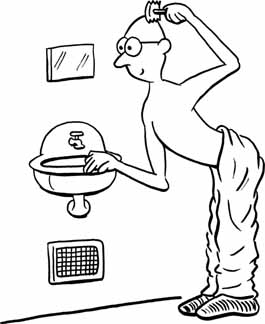
It did improve Robert's looks.
Robert also became quite garrulous. If anyone gave him the opportunity, he would talk their ear off, and once he started talking it was hard for the people to get away. Even the prison chaplain found he had to duck down and crawl past Roberts's window (which was sometimes kept open) or he'd get buttonholed by Robert. Robert caught him doing this once, much to the chaplain's embarrassment. The chaplain said he was just joking, but Robert didn't believe him.
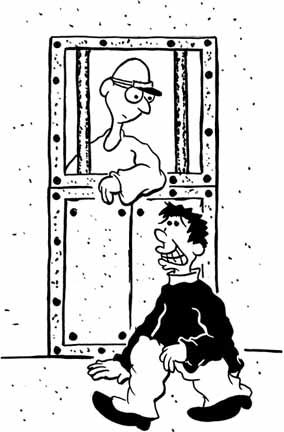
The Chaplain said he was just joking.
Another of Robert's bad habits were terrible table manners. Again this isn't too surprising considering he probably ate all his meals by himself for about thirty years. His technique was to hunker down over his plate and shovel the food into his mouth with his fingers. Robert himself realized his table manners were "atrocious", but there was no real reason for him to change.
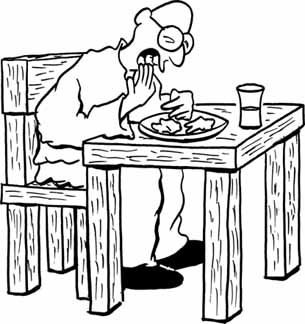
Even Robert admitted his table manners were "atrocious".
Robert kept applying for parole even though it is questionable by the 1950's whether he really wanted to get out or not. Certainly in his hearings he was usually at his personable worst. Once he said he would ACCEPT parole if he could live where he wanted, do what he wanted, and be totally free of any requirement to report to a parole officer. Naturally the parole was denied. Another time he was asked by an officer what he would do if he was released. Robert promptly said he had a list of people he had to kill. This reply may not have been serious (Robert had a strange sense of humor), but with answers like that, it didn't matter how many petitions bird lovers sent to Washington. Robert was never paroled.
Robert would probably have faded even from the memories of the bird lovers who knew him from Leavenworth except that a young writer named Tom Gaddis learned about him. The two men began to correspond, and soon Tom realized he had a great story on his hands. That would have been true even if Tom had stuck to the unvarnished truth. But the trouble was that Tom got most of his information directly from Robert, and so it tended to be a wee bit biased. When the book came out in 1955, it made a bit of a flurry, but it wasn't until Burt Lancaster (himself a voracious reader) got the book and decided to make a movie that Robert became an international celebrity.
Neither the book nor the movie helped Robert's case since the prison authorities were irritated to no end. What they found particularly galling was where at the end of the movie it was stated that Robert's requests for parole had always been denied. That Robert was largely to blame for that didn't make the authorities any more inclined to be sympathetic to the book, the movie, or Robert.
By the late fifties, Robert was pushing seventy. But although he was generally in good health, the then warden at Alcatraz, Paul Madigan, was a humane man and felt Robert would do much at the Medical Center for Federal Prisoners at Springfield, Missouri. Robert, though, had misgivings. Although Springfield was a showcase facility surrounded with absolutely beautiful grounds and the inmates lived in dormitory style quarters, the guards had a reputation of being among the toughest in the prison system. The story was that when dealing with a more difficult inmate, the guards would grab the man and choke him into unconsciousness. Warden Madigan, though, told Robert his fears were groundless, and finally Robert agreed to go. He was transferred to Springfield in July, 1959.
Although Robert was now out of Alcatraz and out of solitary, he never gave up trying to get Palmer's original life in solitary directive ruled illegal. He also wanted to get his book on prison life published. His petitions had been bouncing back and forth for years, and finally, at a hearing on November 7, 1963, the judged issued a definitive ruling.
Regarding the book, the judge sided more with the administration, but he cut Robert a little slack. The Prison Bureau did have the right to say what the inmates could publish, he ruled. But he also ordered that the book must be properly reviewed by them and evaluated. The administration did promptly review the book and just as promptly refused permission to publish.
But as far as Robert's life term in solitary was concerned, here the judge ruled entirely with Robert. The sentence was and always had been illegal, he said. But since Robert was now at Springfield, fully integrated into the general population, it was kind of a moot point. Nevertheless, Robert felt that at long last he had been vindicated. A photograph of him leaving the courthouse shows a kindly grandfatherly figure grinning ear from ear. Robert was seventy-two and had been in prison for 54 years. He died two weeks later.
Bibliography
The Birdman of Alcatraz, Tom Gaddis, Random House, 1955. The first book about the Birdman. The basic facts are with the caveat that it's largely told from Robert's viewpoint. The book is unique in that Robert was a first hand source and the book was published during his lifetime.
The Birdman of Alcatraz (Movie) - MGM (1962) starring Burt Lancaster with Karl Malden. Like most movies it has to compress the action and invent some composite characters, and it also depicts Robert in his later years as a gentle genius. Overall, though, it really is a good movie if you don't take it too literally and both Burt and Karl were fantastic actors. Both the book and the movie refreshingly picture the prison life without demonizing either guards or wardens OR inmates, something that is virtually unheard of in prison movies today. In particular life on Alcatraz was pictured honestly, although it's not likely that Robert really could recite the engine specification for a Boeing 707 from memory.
Birdman: The Many Faces of Robert Stroud, Jolene Babyak Ariel Books, Berkeley, California, 1994. The most up to date biography. The author lived on Alcatraz as a child while her father was associate warden. She later researched Robert's prison records and files and also interviewed former guards and inmates who knew him personally. The book neither puts Robert down nor puffs him up, but tells the story as best as the records allow.
Alcatraz '46: Anatomy of a Classic Prison Tragedy, Don DeNevi and Philip Bergen, LesWing Press, San Rafel, CA, 1974, Well written and interesting booklet derived from records and interviews of guards and inmates. Not exactly a scholarly work as it is filled with direct quotes, making it appear that the escaped convicts had stenographers assigned to record every word even when they were sitting in solitary confinement, escaping, or murdering guards.
Co-author Phillip Bergen was the guard who spoke with Robert during the blast out. Phillip later said he believed the shelling was probably going to stop soon anyway, but you'd have a hard time convincing any of the prisoners in D-Block of that.
Alcatraz Inside, The Hard Years, 1942-1952, Jim Quillen, Golden Gate National Parks Association, 1992. Not a famous, "high-profiler", but after his conviction for kidnapping, Jim was an ornery prisoner and ended up on Alcatraz from 1942 - 1952. He knew Stroud and was part of the protest when Robert complained about having only an orderly, not an MD, check him out. Jim was later paroled and was hired as X-ray technician in a California hospital (he learned X-ray at the Alcatraz infirmary). After Jim retired he became one of the most articulate sources of information for researchers of Alcatraz.